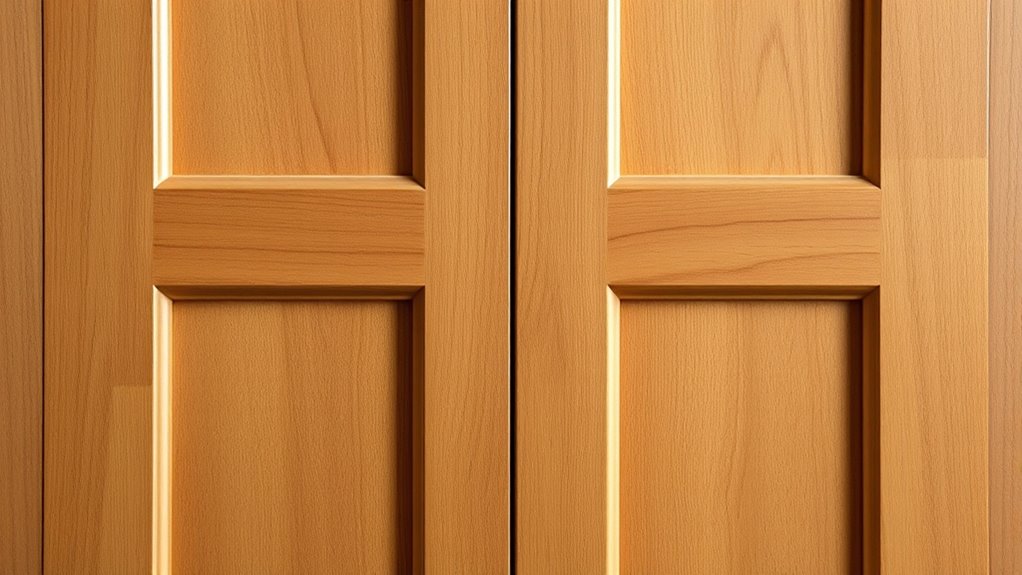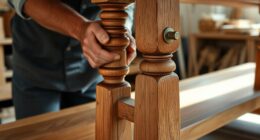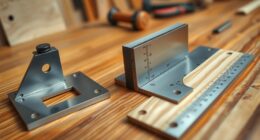Shaker cabinet doors feature a timeless, simple design with flat panels framed by stiles and rails. You’ll notice the stiles run vertically along the sides, while the rails connect them at the top and bottom, forming a sturdy frame. These parts are joined using traditional mortise and tenon joints, which provide strength and a seamless look. If you’d like to explore how this craftsmanship creates both durability and elegance, keep exploring further.
Key Takeaways
- Shaker cabinet doors feature stiles (vertical) and rails (horizontal) forming a sturdy frame around the central panel.
- Mortise and tenon joints securely connect rails to stiles, ensuring durability and a seamless appearance.
- The frame’s precise fit maintains the door’s shape, stability, and resistance to warping over time.
- The joinery is hidden within the frame, preserving the door’s smooth, clean aesthetic characteristic of Shaker style.
- This construction method provides strength, longevity, and a refined, understated look to the cabinet doors.

Shaker cabinet doors are renowned for their simple, clean lines and exceptional craftsmanship, making them a popular choice for both traditional and modern kitchens. Their timeless appeal comes from the straightforward yet sturdy construction methods used to assemble each door. When you examine these doors closely, you’ll notice that their strength and durability rely heavily on the joinery techniques employed, especially in the rails, stiles, and panels. One of the most traditional and reliable methods used in Shaker cabinetry is mortise and tenon joinery, often combined with rail and stile construction.
In a typical Shaker door, the stiles are the vertical pieces running along the sides, while the rails are the horizontal members at the top and bottom. These components are crafted to fit precisely together, creating a frame that supports the central panel. The mortise and tenon joint is fundamental here; it involves cutting a rectangular hole, known as the mortise, into one piece—usually the stile—and a corresponding projection, called the tenon, on the end of the rail. When you insert the tenon into the mortise, it locks the pieces securely, forming a strong, lasting connection that resists racking and movement over time. This method is preferred in Shaker cabinetry because it offers exceptional strength without the need for additional fasteners, maintaining the door’s clean, unadorned appearance.
The rail and stile construction, combined with mortise and tenon joinery, ensures the door frame remains square and stable throughout its lifespan. The precision required in cutting the mortise and tenon contributes to a seamless fit, which not only enhances durability but also results in a sleek, refined look. As you handle a well-crafted Shaker door, you might notice that the joints are tight and flush, reflecting the craftsmanship involved. This construction approach reduces the need for glue or nails, allowing the wood to expand and contract naturally with humidity, minimizing warping or cracking.
In addition to strength, these joinery techniques uphold the aesthetic simplicity of Shaker design. The mortise and tenon joints are hidden within the frame, preserving the smooth, flat surfaces that define Shaker style. Whether you’re installing new cabinets or restoring existing ones, understanding the importance of mortise and tenon, along with rail and stile construction, helps you appreciate the quality behind these timeless doors. This traditional joinery not only guarantees longevity but also embodies the craftsmanship that makes Shaker cabinets a lasting symbol of understated elegance.
Frequently Asked Questions
What Wood Types Are Best for Shaker Cabinet Doors?
For shaker cabinet doors, you should choose woods like oak, maple, or cherry, as they offer beautiful matching wood grains that enhance the classic look. These woods also take finish options well, giving you flexibility in stain or paint choices. Oak provides durability, while maple and cherry add warmth and elegance. Consider your style and durability needs to pick the best wood type for your shaker doors.
How Do I Maintain Shaker Cabinet Doors Over Time?
Did you know that proper maintenance extends your shaker cabinet doors’ lifespan by up to 50%? To keep them in top shape, regularly clean with gentle techniques like a damp cloth and mild soap. Avoid harsh chemicals that can damage the finish. Reapply a protective finish every few years to preserve the wood’s beauty and durability. Consistent cleaning and finishing preservation guarantee your shaker doors stay stunning and functional over time.
Can Shaker Doors Be Customized in Size and Design?
Yes, you can customize shaker doors in size and design. Many manufacturers offer custom size options, allowing you to fit your cabinets perfectly. You also have design flexibility, so you can choose different wood stains, paint finishes, or even modify the panel styles to match your aesthetic. This way, you get shaker doors that suit your space and style preferences, ensuring a seamless and personalized look for your cabinets.
What Hardware Options Complement Shaker Cabinet Doors?
You can choose from a variety of hardware options to complement your shaker cabinet doors. Opt for hinge styles like soft-close or European hinges for smooth operation. Pair these with handle finishes such as brushed nickel, matte black, or antique brass to enhance the classic look. Selecting the right combination of hinge styles and handle finishes allows you to tailor your cabinets to match your personal style and kitchen decor seamlessly.
Are Shaker Cabinet Doors Suitable for Outdoor Use?
Imagine you’re designing an outdoor kitchen, and you choose shaker cabinet doors. They can be suitable if made from weather-resistant materials like marine-grade plywood or composite wood, ensuring durability against the elements. Proper sealing and finishes enhance weather resistance, making these doors last longer outdoors. With the right materials and protective coatings, shaker cabinet doors offer a stylish, durable option for outdoor spaces while resisting moisture and temperature changes.
Conclusion
Now that you understand how rails, stiles, and panels come together in shaker cabinet doors, you’ll see these timeless designs everywhere — it’s like they’re quietly guiding your eye. It’s no coincidence that their simple, sturdy joinery has stood the test of time, just like your growing appreciation for quality craftsmanship. So next time you admire a shaker door, remember, it’s the perfect blend of tradition and skill, built just for you to enjoy for years.









